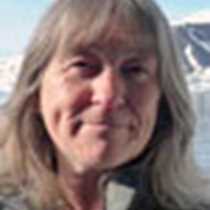Hornsund, South Spitsbergen
It is our first full day of our Svalbard adventure and hopes are high that we may experience something magical of the Arctic wilderness and its wildlife. Yet, as we sailed southwards past the ‘pointed peaks’ of Spitsbergen gleaming on our port side, no one quite anticipated the early morning encounters with whales that lay just ahead. Close sightings of fin whales, their blows shooting up into the air, brought everyone out onto the decks before breakfast, to watch two groups, more than half a dozen individuals, absorbed in feeding activity, occasionally flashing their asymmetrical white patches on their right-hand lip.
Then something else came into view, even larger and possibly more remarkable: a blue whale was also feeding in the same rich meeting point of deep and shallower water. One of the largest creatures ever to have lived, a blue whale is a rare sight here for even the most experienced nature watcher (it is estimated that the global population of these animals is only about 15,000), but then, a second one appeared, and then, another. This group of three individuals worked together, circling clockwise, surfacing and eventually diving with a final flourish of a massive fluke. Above the surface they appear mottled grey, but seen through the water, particularly when one came momentarily right alongside the ship, they shimmer blue.
After breakfast, we entered Hornsund, one of the loveliest of the fjords. Belugas were soon spotted just off the fast ice at the head of the fjord where three glaciers descend to the shore, cream-coloured spots rising and falling silently along the ice edge. Then our first polar bear was observed on the ice, still some distance off but moving towards us, hoping for a lunch of ringed or bearded seal. In the afternoon, Burgerbukta, on the north side of the fjord, provided a perfect sheltered theatre for kayaking and Zodiac cruising among pieces of sculptured ice floating away from the glacier face.
Hornsund is beautiful, with exquisite scenery and richness of wildlife, but it also has historic interest. Lying on the southwest corner of Spitsbergen close to the Gulf Stream it was one of the first inlets to be explored. English whalers established bases on the southern shore as early 1618, marked by a legacy of scattered graves. Overwintering Russian trappers from the arctic shores of the White Sea came here in the 18th and 19th centuries, followed by Norwegian hunters. The Austro-Hungarian expedition of 1872-3 gave names to most of the glaciers and landforms (part of the endeavour that also discovered Franz Josef Land), and between 1899 and 1904 the Russian section of the Arc de Meridian expedition had a scientific research station on the southern shore, used to establish the true shape of the Earth.




